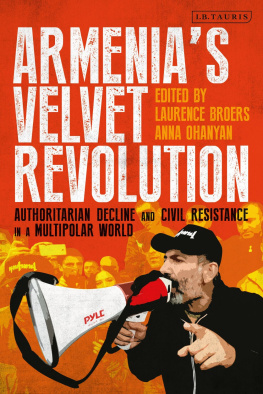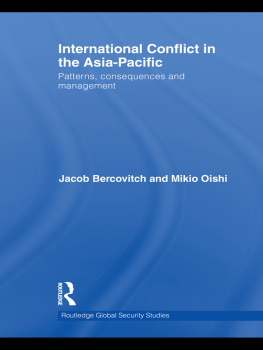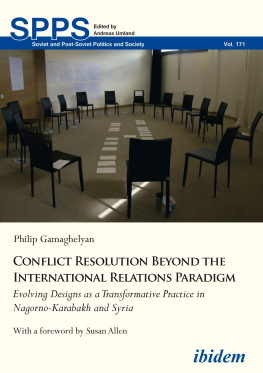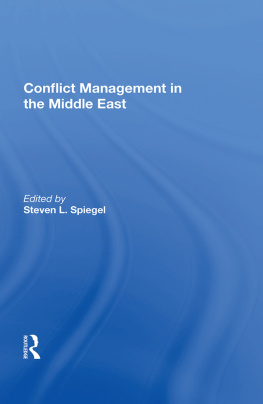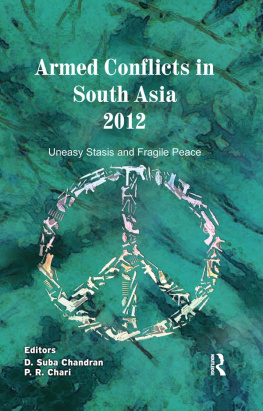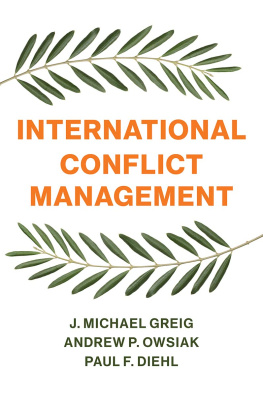Networked Regionalism as Conflict Management
Anna Ohanyan
Stanford University Press
Stanford, California
Stanford University Press
Stanford, California
2015 by the Board of Trustees of the Leland Stanford Junior University.
All rights reserved.
No part of this book may be reproduced or transmitted in any form or by any means, electronic or mechanical, including photocopying and recording, or in any information storage or retrieval system without the prior written permission of Stanford University Press.
Library of Congress Cataloging-in-Publication Data
Ohanyan, Anna, author.
Networked regionalism as conflict management / Anna Ohanyan.
pages cm.
Includes bibliographical references and index.
ISBN 978-0-8047-9386-5 (cloth : alk. paper) ISBN 978-0-8047-9493-0 (pbk. : alk. paper)
1. Regionalism (International organization) 2. Conflict management. 3. Peace-building. 4. Pacific settlement of international disputes. I. Title.
JJZ5330.O36 2015
341.24dc23
2014036160
ISBN 978-0-8047-9494-7 (electronic)
Printed in the United States of America on acid-free, archival-quality paper. Typeset at Stanford University Press in 10/14 Minion.
To ARAM
Contents
Tables and Figures
Tables
Figures
Preface
As a teenager in Armenia in the early 1990sduring the very early years after the dissolution of the Soviet UnionI recall standing in a tiny local shop, in a remote village near the shores of Lake Sevan, holding a packaged bar of exceptionally brightly colored orange hand soap, its floral scent so remarkable at the time that I can recall it to this day. There was nothing particularly special about that soap, as it turns out, except that it was manufactured in Turkey, was likely destined for Western markets, yet had somehow found its way into my hands in a faraway corner of Armenia.
I distinctly remember feeling guilty for liking that bar of soap. Wariness of all things Turkish was instinctive, a legacy of the genocide of the Armenians by Ittihadist Turkey in the pre-Soviet period. That legacy involved a genocide so successful and complete that it would be used a few short decades later as a template by Raphael Lemkin and the Allies in constructing the legal basis for the Nuremberg Trials. And that difficult legacy had endured, with Soviet Armenia comprising so many children and grandchildren of survivors of the Armenian genocide, and had been reinforced in the present day by a border unilaterally blockaded by a seemingly unrepentant modern Turkey.
But what puzzled me most as I stood in that tiny shop, handling that aromatic bar of soap, were not issues of physical security or existential threat, but rather more mundane logistical questions. How had this Turkish bar of soap come to find its way to the shores of this mountain lake in landlocked Armenia, across closed land and air borders. How had it taken the path it had, to land in Armenia, from a place whose government had severed all diplomatic links with the destination country? Who was setting the rules, if there were any, that consented to retail trade in minor consumer goods, no doubt conducted by myriad circuitous means, prevailing over a deep, painful, unresolved past, and an insecure present?
But trade did prevail. And even today, despite a now decades-long unilateral blockade and the absence of diplomatic relations, many more Turkish toiletries, along with a long list of other consumer goods, regularly find their way from Turkish factories to remote Armenian villages. Although the formal research for this book started in the summer of 2010, it is those memories from the early 1990s, in small shops across Armenia, that have tacitly shaped the work presented in this book.
In circumstances such as those of Turkish-Armenian relations, concepts of regionalism and nonstate actors are no substitute for human rights protections and long overdue mechanisms of reconciliation, atonement, and redemption. However, the idea of networked regionalism as a component of conflict management strategiesthe theoretical and policy framework introduced in this bookoffers a pathway toward building relations between societies and communities in parallel and concurrent with other processes of formal diplomacy between governments. In particular, this book has three messages. First, peaceful coexistence is too important to be left to politicians alone, particularly in regions with immature democracies and persistent authoritarian tendencies. At the same time, it is too optimistic to expect that flows of trade and capital alone can transform conflict management processes for the better. And it is equally unrealistic to leave the business of peace solely to economists and private enterprise.
This book is a call for careful calibration and more strategic deployment of economic forces in politically divided areas, with a focus on strengthening regions toward managing local conflict. It is an appeal for a deeper understanding of the ways that various economic and political stakeholders currently intersect, and should intersect, in politically divided areas, and in the regions to which they belong. It is also a quest to identify economic and political stakeholders that unfortunately fail to cross each others paths, reflecting an unfortunate gap in the global conflict management infrastructure. It is a plea for humility to policy-makers, national or international, and an appeal to seek out populations across conflict lines and border areas who suffer in the shadows of unresolved and frozen conflicts. There is significant untapped potential, which needs recognition and utilization, for more effective peace processes in politically divided regions; regional approaches to individual conflicts should be a significant part of any peace process.
Second, networked regionalism as a conflict management strategy also upsets a belief dominant among international and national policy-makers in conflict regions: that some regions are just broken, and no regional integration can occur unless and until political conflicts between states and nations are resolved. I present here an alternative narrative: there are no broken regions, but only collections of weak states. Unresolved conflicts are often visible, and are erroneously and easily blamed for the lack of regional integration in conflict areas. The study in this book shows that regional integration is lacking primarily because of poor administrative and governance capacities of individual states, shortages of democracy, rudimentary business practices and information scarcities at a regional level. Most of all, this work highlights the need for regional institutions that can be true advocates for those stakeholders that stand to benefit from greater regional cooperation. Giving such regional groups a voice, and creating a forum to advance their interests, can go a long way both for the socioeconomic development of constituent states in the region, and for the management and resolution of precarious frozen conflicts.
Third, networked regionalism as a conflict management strategy represents a challenge for us all to rethink the global infrastructure of conflict management in the context of post-American hegemony and increasing degrees of nonstate violence worldwide. States, particularly in the developing world, are losing their monopoly over the means of violence. The contemporary conflict management infrastructure remains rooted in policies designed during the Cold War for interstate conflict. The multilayered and multiplayer realities in conflict regions today require other responses. Regionalism, and its promotion, are one such important component to a restructuring of global conflict management policies. And it is with the hope that this book makes a convincing case to that end that I present this work.
Next page

